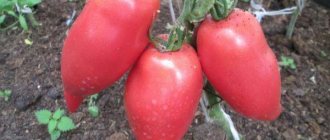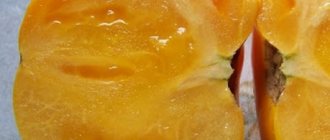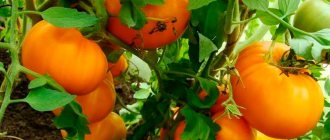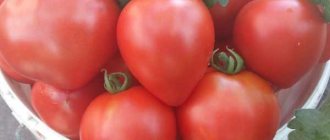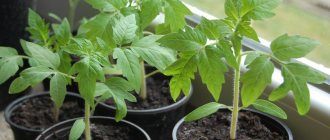Gardeners love to experiment by growing tomatoes in unusual colors and shapes. At gardening markets, green, black and blue tomato seeds are abundantly available. Unfortunately, not all exotic varieties have a pleasant taste and produce crops in our latitudes. Therefore, every cultivation of a new tomato variety is a risk.
Among the proven varieties with interesting fruits is the Honey Salute tomato. It produces colorful yellow-red berries with a distinct taste and rich composition.
Description of the variety
The tomato variety Honey Salute was developed in 1999. It was added to the Russian State Register only in 2004.
This variety is produced by many manufacturers. It is popular with gardeners around the world. It is especially often grown in Russia and the countries of the former CIS.
Distinctive features of the Honey Fireworks
Honey Salute tomatoes are distinguished by the unusual appearance of the fruit. The berries of this variety at the ripe stage are bright yellow, with red streaks and spots.
The tomato taste is also impressive. It is sweet, with a honey aftertaste and mild sourness. The pulp of such fruits is dense and juicy.
The variety is considered large-fruited. The weight of its fruit varies between 350-450 g, but there are specimens weighing up to 900 g.
Honey Salute tomatoes are consumed fresh. They are not suitable for preservation whole or in slices, not only because of their size, but also because of their thin skin. Some gardeners use this variety to make juices and sauces.
When fresh, fruits retain the greatest amount of nutrients. Yellow-red berries contain a lot of beta-carotene, which has a beneficial effect on vision, improves the condition of the skin, hair, blood vessels and heart, and improves immunity.
The variety itself is susceptible to fungal diseases, but resistant to viral ones.
The downside of the Honey Salute is its high maintenance requirements. It forms a large number of stepsons, so it needs regular formation. The heat-loving nature of this tomato does not allow it to be grown in open ground conditions in most regions of our country.
General characteristics
The characteristics of the Honey Salute tomato will interest experienced gardeners. Beginning gardeners should start with less capricious varieties.
Description of the Honey Fireworks:
| Parameter | Indicators |
| Bush type | Indeterminate variety (grows throughout the entire growing season). In a greenhouse it grows up to 1.8 m, in open ground up to 1.5 m. The bushes have powerful and thick stems. The plant forms many stepsons and branches heavily. The bushes have an average number of leaves. The leaves are bright green, simple without pubescence. Inflorescences are intermediate. The first inflorescence is ordered in the axil of 10-12 leaves. The rest every 2-3 sheets. The fruits are formed in clusters. |
| Growing method | Heat-loving variety. Outdoor cultivation is possible only in the southern regions. In other regions, greenhouse planting and film shelters are practiced. |
| Productivity | Average. From 1 sq. m of tomato plantings harvest up to 7 kg. fruits |
| Fruit | Large ones. On average, the berries reach a weight of 350-450 g. The largest specimens reach 900 g. The color of the berries is yellow, with pink and red spots and stripes. The inside of the fruit is dark yellow with pink spots. There are no green or white spots at the base. The shape of tomatoes is round, flattened at the top and bottom. There is a faint ribbing at the base. The berries taste sweet, with a honey aftertaste. The pulp is dense but juicy. Inside each tomato there are 6 seed chambers with a small number of seeds. |
| Transportability | Low. The fruits have thin skin that is easily damaged during transportation. Honey salute can be stored in the refrigerator for no more than a month. |
| Ripening time | Late ripening variety. The first harvest ripens 4 months after sowing the seeds. Fruiting continues until the end of September. |
| Disease resistance | Immunity is low. |
Analogs
The Honey Salute variety has no analogues that completely replicate all the characteristics. But there are varieties and hybrids that differ in the color and shape of the fruit, but have a similar taste.
Orange berry variety: has large orange fruits, up to 0.5 kg, sweet and juicy. The yield of the variety is the same as that of Honey Salute.
The Pink Fig variety produces large, heart-shaped, ribbed fruits weighing up to 400g, scarlet with a pink tint. The taste is sweet, and the tomatoes themselves are meaty and juicy.
The Pink honey variety is characterized by very large fruits, weighing up to 1 kg, sweet, the pulp has a sugar structure at the break. Pink colour.
Tomatoes of the Sugar Bison and Sugar Giant varieties have a sweet taste.
Growing seedlings
Seeds for seedlings are sown in early March in all regions. This is due to the fact that the Honey Salute tomato in the central and northern part of the country is planted only in a greenhouse. Picking in protected ground is possible much earlier than in open ground
Working with planting material
Before starting to grow seedlings, prepare planting material. This reduces the likelihood of plant infection and speeds up seed germination.
Before purchasing seeds, be sure to check their expiration dates. Expired planting material will have a low chance of germination.
To select the most viable seeds, they are soaked in saline solution for half an hour. To prepare the product, stir 1 tsp in a glass of water. salt. Specimens that float up are thrown away, and those that sink to the bottom are washed and used for planting.
Due to the instability of Honey Salute to tomato diseases, its seeds must be treated with a disinfectant composition. Some manufacturers sell already treated planting material, as evidenced by the inscription on the package and the orange or green color of the seeds. In other cases, the seeds are disinfected independently.
To do this, they are soaked:
- in a light pink solution of potassium permanganate for half an hour;
- in a solution of soda for 12 hours;
- in aloe juice diluted in half with water for 12 hours.
After dressing, the seeds are treated with a growth stimulator. I often use Epin, in which the seeds are soaked for 3-5 hours.
Selection of soil and containers
Usually the seeds are sown in one common container. Stores sell special wooden boxes and plastic trays.
The following materials are also used for these purposes:
- disposable tableware;
- trays for semi-finished products;
- trimmed 5-6 liter bottles.
To pick plants into individual pots, use containers with a volume of 300-500 ml. For these purposes, special pots, cut-off bottles or disposable cups are used.
The containers are disinfected before use. To do this, they are soaked in a strong solution of potassium permanganate.
You can prepare soil for tomatoes yourself or buy it in a store. The soil for tomatoes should be light and nutritious. To prepare the soil, turf, peat and humus are mixed in different proportions. Spit substrate or river sand is added to the resulting composition.
The soil is disinfected. To do this, water it with a solution of potassium permanganate or boiling water. Another option is to calcine the soil in the oven.
Sowing seeds
Soil is poured into the container so that there is a distance of 2 cm to the edge. Grooves are made in the soil, 1 cm deep. The distance between them should be 3 cm.
Seeds are placed in the grooves at a distance of 1.5 cm from each other. They are sprinkled with earth on top without compacting it.
Boxes with seeds are moistened with warm, settled water. After this, they are covered with film and placed in a warm place. Depending on the room temperature, seed germination times vary from 3 to 7 days.
It is convenient to grow seedlings in peat tablets. To do this, such blanks are soaked until they swell, after which seeds are placed in the holes. Next, all the tablets are placed in one container and covered with film.
Seedling care
Caring for seedlings should be regular. Only in this case will it be possible to grow healthy and viable plants. Below are the main nuances that a gardener who grows his own tomato seedlings needs to know about:
- Seeds do not need sunlight before germination. Therefore, they are placed in a dark, warm place. Sometimes gardeners cover the boxes with dark film to speed up germination.
- When the first shoots appear, containers with seedlings are placed in a well-lit place. If there was a dark film on them, it is removed. If the boxes are covered with transparent glass, then leave it in the first week after germination.
- Before the seeds germinate, the soil is moistened with a spray bottle. After the first shoots appear, water the plants with a syringe. Use water at room temperature.
- When the first true leaves appear on the plants, they are picked into individual containers. The root is not pinched. This slows down plant growth.
- After picking, the tomatoes are watered from a watering can. It is important that water does not fall on the ground part.
- During the entire period of growing seedlings, plants are fed 3 times. The first time fertilizer is applied 2 weeks after picking, the second time after 2-3 weeks, the 3rd time 3 days before planting in the greenhouse.
- 14 days before picking tomatoes to a permanent place, they begin to harden. To do this, they are taken out to the balcony, gradually increasing the time spent in the fresh air.
general characteristics
Tomatoes Honey Drop are medium early. The variety is indeterminate and can be grown both in open and protected ground.
This plant can reach a height of 2 m when growing in a greenhouse, and up to 1.5 m when grown on a plot. The tomato is actively gaining green mass and is distinguished by a large number of stepsons, and therefore the bush requires formation.
The fruits appear in stages, from the lower ovaries. The duration of fruiting also depends on external factors and varies from 1 to 2.5–3 months. The last harvest must be harvested before the first frost.
Store the harvest in wooden boxes, with sawdust or other material that can protect from excess moisture. It is better in a dark and cool place, with humidity no more than 75%. Under such conditions, tomatoes retain their presentation and taste for a long time.
Description of the bush
Like any indeterminate variety, Honey Drop is distinguished by its tall growth and powerful bush, with a large number of stepsons and foliage.
With proper care of the plant, this allows you to effectively use the entire space of the greenhouse and harvest up to 4 kg of tomatoes from it.
- The stems are light green, thin and weak.
- Potato leaves, large, dark green.
- The bush actively gains green mass and produces shoots and shoots throughout the entire growth period.
- Flowering occurs in early June.
- Inflorescences are simple and semi-complex.
- The grapes are rapidly appearing. On average, 5-7 pcs. on one stem.
- The ovaries form gradually. 10-15 pcs. on every branch.
To obtain maximum yield and to prevent diseases, the bush must be formed into 1-2 stems. You also need to pinch it, tie it up, and remove excess foliage and shoots as necessary.
Description of fruits
It is because of the external characteristics that the variety got its name: the tomatoes have a unique pear- or teardrop-shaped shape, and after ripening they acquire a bright yellow color.
The average weight of one fruit is 15-30 g. The pulp is dense, juicy, sweet, with a pronounced aroma.
The seeds are soft and small. They separate easily and remain viable. The durable skin allows the crop to be stored for a long time and transported without problems.
Fruits are formed gradually on one cluster. It takes up to 1.5 weeks for the entire branch to fully ripen.
Productivity
The fruits ripen in stages
Ripe tomatoes are harvested from the bushes in stages, often not in bunches, but individually.
Fruit ripening begins from the lower branches and ends in the apical part. All tomatoes on one bunch have the same weight and size.
The average yield from one bush is about 4 kg. For a plant grown in open ground, this figure is lower - up to 3 kg.
If you look at the area occupied, then in a greenhouse there will be about 9 kg per 1 m² of soil, and in an open area - 5.5 kg.
Despite the overall low weight of the fruit, Honey Drop is considered a high-yielding variety.
Application area
Due to their unique taste, Honey Drop tomatoes are often consumed raw: in salads and side dishes. They are also good for canning whole fruits or making jam.
They are also actively used for dietary nutrition, because... yellow varieties contain fewer calories.
However, due to the low ascorbic acid content, the products are not suitable for pickles. It is also rarely used for industrial processing (juices, ketchups, pastes, sauces).
Breeding regions
This variety tolerates drought and sudden drops in temperature well, but begins to suffer from lack of sun and high humidity.
For optimal growth and to obtain maximum yield, tomato requires stable sunny weather and an air temperature of at least 20°C.
In this regard, it is better to cultivate in the Central, Southern and Volga districts.
- In Tver, Smolensk, Bryansk, Kaluga, Yaroslavl and Kostroma regions.
- In the republics of Bashkortostan, Mari El, Mordovia, Tatarstan.
- In the Perm and Krasnodar regions.
- In Ulyanovsk, Chuvash, Orenburg regions.
- In Astrakhan, Rostov, Volgograd regions.
However, it is very fruitful to grow tomatoes in the north of Kazakhstan, almost throughout the entire territory of Ukraine, Poland, southern Belarus, and in other countries with a warm and slightly dry climate.
Agricultural technology of the Honey Salute
Honey salute is planted in a permanent place in May. The method of its cultivation depends on the region:
- southern - in open ground;
- central ones - in film shelters;
- northern ones - in a glazed greenhouse.
3 days before planting tomatoes in a permanent place, they are watered and fed. Phosphorus and potassium fertilizers are used.
Planting seedlings in a permanent place
The beds for planting tomatoes are prepared in advance. They are cleared of plant remains and dug up. To enrich the soil, fertilizers are added to it: mullein, humus, etc. If there is a need to reduce the acidity of the soil, then it is mixed with dry lime.
In the spring, the soil is dug up again. It is watered with a solution of copper sulfate. Dig holes that are arranged in rows in a checkerboard pattern. Use a 40 x 70 cm scheme. For 1 sq. m place 4 plants.
The tomatoes are removed from the pots and placed in the holes. 1 liter of water is poured into each recess. The holes are filled with soil.
Caring for Honey Fireworks
Honey salute is a tall plant with large fruits. Therefore it needs to be tied up. The bushes are attached to a support as they grow. Additionally, the clusters with fruits are tied up.
Form a tomato into 1-3 stems. The more stems remain, the smaller the fruits will be and the later they will ripen. When forming a tomato into 2 stems, the best yield indicators are observed.
The growth of the Honey Fireworks is artificially limited. To do this, pinch the top of the main stem after 4 brushes. The growth point of additional stems is limited after the appearance of the 3rd cluster.
When pinching tomatoes, not only the stepsons are removed, but also all the leaves up to the first ovary. This will speed up fruit set and ripening. Stepping is carried out no more than once a week. No more than 3 leaves are removed at a time.
Watering tomatoes should be regular and plentiful. Each adult plant consumes at least 2 liters of water. Use warm, settled water. After planting the plants in a permanent place, the soil is moistened for the first time after 10 days.
Tomato bushes are shaken regularly. This promotes their pollination.
Tomatoes are fed 3-4 times per season. The first fertilizing should include nitrogen. The second time mineral fertilizers are used. Then the tomatoes are watered with organic compounds. After the first fruits appear, formulations with potassium and phosphorus are used.
The bushes are sprayed with foliar fertilizers twice a season. Such fertilizers must contain boron.
Characteristics of tomatoes variety Honey Drop
The Honey Drop tomato cannot be classified as high-yielding. It is mainly valued for its attractive, even decorative, tasty fruits. The maximum yield per bush is 3 kg of tomatoes, and in open ground - even less, which is prohibitively small for a huge bush, but for cherry tomatoes this is a very good indicator. In terms of ripening time, the variety is classified as mid-early; harvesting begins 110–115 days after emergence.
The fruits are very sweet, rich in taste and aroma. If tomatoes are picked unripe, they can be stored for up to one and a half months, gradually ripening. Their main purpose is to eat fresh, but they are also quite suitable for whole-fruit canning, although some tomatoes in jars crack.
The fruits, of course, are not exactly droplets, but a lot of them fit in the palm of your hand
Resistance to diseases is high, resistance to cold is low. When weather conditions fluctuate (temperature and humidity, as well as soil), tomatoes are prone to cracking. At the same time, the variety has no special requirements for agricultural technology; it is available for cultivation by any gardener.
The advantages of the Honey Drop variety include:
- excellent, even dessert taste of the fruit;
- good yield for a small-fruited variety;
- good disease resistance;
- extended fruiting;
- keeping quality of tomatoes picked in a not quite ripe state.
Children really like the interesting appearance and honey taste of these tomatoes, which is successfully used by parents to improve the health of their offspring. They are also used in dietary nutrition.
The disadvantages of the variety are:
- the tendency of fruits to crack both on the bushes and during canning;
- the need for frequent pinching and tying;
- capriciousness in watering mode.
The inconvenience of growing this variety of tomatoes is that the slightest delay in the formation of the bush leads to the fact that several plants planted nearby form almost a taiga, through which it is difficult to get through. Flaws in watering (overwatering or, conversely, drying out the soil) quickly lead to massive cracking of the fruit. Experienced gardeners advise planting only 2-3 Honey Drop bushes on your plot: this is enough to taste the tomatoes, decorate various dishes with them from time to time, and spoil the kids. They are not suitable for juice (they clog the nets with seeds), cutting them into salad is a chore...
Common gardening mistakes
The Honey Salute variety is quite difficult to care for. Beginning gardeners often make mistakes that increase the risk of disease and plant death:
- Avoid mulching. Mulch retains moisture in the soil, slows down the growth of weeds, prevents roots from freezing, and becomes an additional fertilizer for tomatoes.
- Spraying tomato bushes with water. Tomatoes do not like liquid getting on their greens. This mistake often leads to withering and death of plants. Drops of liquid on the bushes attract pests.
- Applying large amounts of fertilizer. In this case, the tomatoes will be covered with a lot of greenery, but the fruits will be small and sparse.
- Thickening of plantings. Tomatoes planted too close create additional shade, which leads to a decrease in tomato yield.
- Preservation of all inflorescences. All incorrectly formed inflorescences must be removed. This will help healthy fruits to form faster, gain maximum weight and ripen.
- Wrong neighborhood. In open ground, tomatoes should not be planted next to other nightshades. This will increase their risk of infection. In a greenhouse, tomatoes should not be adjacent to any other crops.
Diseases and pests
Honey salute has weak immunity to tomato diseases. Therefore, its cultivation requires not only compliance with the rules of prevention, but also the use of additional means for processing the bushes.
Rules for the prevention of tomato diseases:
- Disinfection. Disinfecting compounds are used to treat soil, seeds, containers and garden tools.
- Cleaning up last year's plants. Remains of plants in the beds must be removed and burned. They can be carriers of infection.
- Proper watering. Dry and waterlogged soil is an ideal environment for the development of infections.
- Protection from insects. The above-ground part of tomato bushes is treated with herbal decoctions, soap solution and compositions with colloidal sulfur. Egg shells are poured under the root. Large beetles are collected by hand.
- Preventive treatment of bushes. To prevent the development of fungal diseases, tomatoes are treated 3 times a month with solutions containing copper or Bordeaux mixture.
Agricultural technology and care
Varieties of indeterminate tomatoes require care. The duration of fruit ripening is influenced not only by varietal characteristics, but also by seed preparation, well-grown seedlings, watering and fertilizing regimes, timely topping of the plant, and temperature conditions.
Varieties with long ripening periods are grown using seedlings. If the quality of the greenhouse is good, the seeds are sown earlier than usual, in late February, early March
Seedlings emerge with the appearance of 1-2 permanent leaves. It is important to prevent plants from stretching, maintaining light and temperature balance. Watering should be moderate, with subsequent loosening of the top soil layer.
Additional feeding helps the plant form a strong stem. The plants are transplanted into the greenhouse at the age of 65-70 days, approximately May 10-15. Planting pattern 40 x 60. For single-stem cultivation, per 1 sq. m you can place up to 4 bushes. It should be taken into account that thickened planting lengthens the period of fruiting. Tomato stems are tied to supports, trellises or attached to a garden net. If the plant is formed into one stem, then it is necessary to remove the stepsons in a timely manner. It is also customary to thin out the leaves in the lower part of the bush to the level of the first brush. If you plan to grow two stems, leave a single shoot below the first flower cluster, removing the shoots as they grow. When the plant forms 4-6 flower clusters, pinch out the growing point. Care consists of watering, weeding, loosening the soil. The lower part of the stem is hilled to help form additional root mass. Fertilizing is carried out once every 2-3 weeks with complex preparations or formulations that take into account the individual condition of the plants. The long period of growth and ripening of Honey Salute tomatoes only in the second half of August does not allow us to avoid autumn frosts. To protect the fruits from possible late blight diseases, the bushes are treated with a systemic fungicide.
Simple agrotechnical techniques help to obtain ripe, high-quality fruits within the scheduled time frame. For the “Honey Salute” salad variety, excellent taste is a key characteristic
It is she who attracts the attention of vegetable growers to unusual tomatoes.
Cultivation in closed and open ground
Honey salute is grown mainly indoors. Under such conditions, the yield of the variety increases and the likelihood of infection decreases.
Before planting tomatoes in a greenhouse, you need to treat the walls of the room with copper sulfate or a solution of potassium permanganate. It is advisable to carry out preventive treatments during the growing period of plants.
The windows in the greenhouse are opened daily for ventilation. On cloudy days the room is left closed.
Planting Honey Fireworks in open ground is possible only in the southern regions. Even in warm climates, the yield of tomatoes grown outside of a greenhouse will be reduced, and the risk of infection will increase significantly.
Harvesting and application
Honey Salute tomatoes are harvested in the second half of August. The ripeness of the fruit will be indicated by a dark yellow color and red stains.
When harvesting tomatoes, it is important to preserve the stem. In this case, they will be stored longer. After harvesting, the tomatoes are placed in the refrigerator. There they will stay fresh for no more than a month and a half.
The fruits are used for salads and cooking. This variety is not suitable for preservation.
Tomatoes: advantages and disadvantages
Advantages of the “Honey Fireworks”:
- Extravagant exterior of the fruit;
- Sweet pulp of unusual color;
- Large fruit;
- Increased content of beta-carotene and vitamins.
Tomato variety Honey Salute:
The main disadvantages of the variety:
- Ripens within 4 months, which is why it is practically unsuitable for growing in open ground;
- Requires careful care: pinching, gartering, installing supports;
- Doesn't produce the biggest harvest.
Farmer reviews
Reviews from gardeners about Honey Salute are mostly positive. Everyone notes the excellent taste of its fruits.
Alena Sachuk, Klin: “I grew Honey Salute in a greenhouse. Formed into 1 stem. Excess inflorescences were removed. I regularly treated it with Bordeaux mixture, so the tomatoes did not get sick. At the end of August I collected large fruits, weighing from 400 to 600 g. The taste was very impressive. The berries are sweet, juicy and very fleshy. I’m thinking of planting it again, although there’s a lot of fuss with it.”
Andrey Grigorenko, Belgorod: “I’ve been growing Honey Salute in a greenhouse for two years. The variety is capricious to care for. It is constantly necessary to treat it with various means against diseases and pests and feed it. Clusters with fruits need to be tied up additionally. I grow it for my grandchildren because of the delicious sweet fruits without sourness. Some tomatoes are cracking even though I don’t water them often.”



